Corn smut
Corn smut is a plant disease caused by the pathogenic fungus Ustilago maydis that causes smut on maize and teosinte. The fungus forms galls on all above-ground parts of corn species. It is edible, and is known in Mexico as the delicacy huitlacoche;[4] which is eaten, usually as a filling, in quesadillas and other tortilla-based foods, and soups.
| Corn smut | |
|---|---|
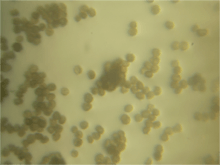 | |
| Ustilago maydis diploid teleospores | |
| Scientific classification | |
| Kingdom: | Fungi |
| Division: | Basidiomycota |
| Class: | Ustilaginomycetes |
| Order: | Ustilaginales |
| Family: | Ustilaginaceae |
| Genus: | Ustilago |
| Species: | U. maydis |
| Binomial name | |
| Ustilago maydis | |
| Corn smut | |
|---|---|
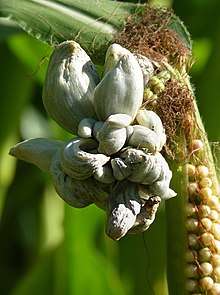 Huitlacoche | |
| Common names | huitlacoche (Mexico), blister smut of maize, boil smut of maize, common smut of maize, corn truffle |
| Causal agents | Ustilago maydis |
| Hosts | maize and teosinte |
| EPPO Code | USTIMA |
| Distribution | Worldwide, where corn is grown[2][3] |
Etymology
In Mexico, corn smut is known as huitlacoche (Spanish pronunciation: [(ɡ)witɬaˈkotʃe], sometimes spelled cuitlacoche). This word entered Spanish in Mexico from Classical Nahuatl, though the Nahuatl words from which huitlacoche is derived are debated. In modern Nahuatl, the word for huitlacoche is cuitlacochin (Nahuatl pronunciation: [kʷit͡ɬɑˈkot͡ʃin]), and some sources deem cuitlacochi to be the classical form.[5]
Some sources wrongly give the etymology as coming from the Nahuatl words cuitlatl [ˈkʷit͡ɬɑt͡ɬ] ("excrement" or "rear-end", actually meaning "excrescence") and cochtli [ˈkot͡ʃt͡ɬi] ("sleeping", from cochi "to sleep"), thus giving a combined mismeaning of "sleeping/hibernating excrement",[5][6] but actually meaning "sleeping excrescence", referring to the fact that the fungus grows in between the corns and impedes them from developing, thus they remain "sleeping".
A second group of sources deem the word to mean "raven's excrement".[7][8] These sources appear to be combining the word cuitlacoche for "thrasher"[9] with cuitla, meaning "excrement", actually meaning "excrescence". However, the avian meaning of cuitlacoche derives from the Nahuatl word "song" cuīcatl [ˈkʷiːkɑt͡ɬ], itself from the verb "to sing" cuīca [ˈkʷiːkɑ].[5] This root then clashes with this reconstruction's second claim that the segment cuitla- comes from cuitla ("excrement").
One source derives the meaning as "corn excrescence", using cuītla again and "maize" tlaōlli [t͡ɬɑˈoːlːi].[10] This requires the linguistically unlikely evolution of tlaole "maize" into tlacoche.
Characteristics
The fungus infects all parts of the host plant by invading the ovaries of its host. The infection causes the corn kernels to swell up into tumor-like galls, whose tissues, texture and developmental pattern are mushroom-like. These galls are made up of hypertrophied cells of the infected plant, along with resulting fungal threads, and blue-black spores.[11] These dark-colored spores give the cob a burned, scorched appearance; this is the origin of the generic name Ustilago, from the Latin word ustilare (to burn).
Biology
Life cycle
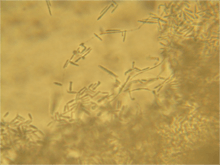
When grown in the lab on very simple media, it behaves like baker's yeast, forming single cells called sporidia. These cells multiply by budding off daughter cells. When two compatible sporidia meet on the surface of the plant, they switch to a different mode of growth. First, they send out conjugation tubes to find each other, after which they fuse and make a hypha to enter the maize plant. Hyphae growing in the plant are dikaryotic; they possess two haploid nuclei per hyphal compartment. In contrast to sporidia, the dikaryotic phase of U. maydis requires infection of the plant to grow and differentiate, and cannot be maintained in the laboratory.
Proliferation of the fungus inside the plant leads to disease symptoms such as chlorosis, anthocyanin formation, reduced growth, and the appearance of tumors harboring the developing teliospores.[12][13]
Mature spores are released from the tumors and spread by rain and wind. Under appropriate conditions, a metabasidium is formed in which meiosis occurs. Resulting haploid nuclei migrate into elongated single cells. These cells detach from the metabasidium to become the sporidia, thus completing the life cycle.
Host/pathogen conflict
Plants have evolved efficient defense systems against pathogenic microbes. A rapid plant defense reaction after pathogen attack is the oxidative burst, which involves the production of reactive oxygen species at the site of the attempted invasion. As a pathogen, U. maydis can respond to such an oxidative burst by an oxidative stress response, regulated by gene YAP1. This response protects U. maydis from the host attack, and is necessary for the pathogen’s virulence.[14] Furthermore, U. maydis has a well-established recombinational DNA repair system.[15] This repair system involves a homolog of Rad51 that has a very similar sequence and size to its mammalian counterparts. This system also involves a protein, Rec2 that is more distantly related to Rad51, and Brh2 protein that is a streamlined version of the mammalian Breast Cancer 2 (BRCA2) protein. When any of these proteins is inactivated, sensitivity of U. maydis to DNA damaging agents is increased. Also mitotic recombination becomes deficient, mutation frequency increases and meiosis fails to complete. These observations suggest that recombinational repair during mitosis and meiosis in U. maydis may assist the pathogen in surviving DNA damage arising from the host’s oxidative defensive response to infection, as well as from other DNA damaging agents.
Uses
Model organism
The yeast-like growth of U. maydis makes it an appealing model organism for research, although its relevance in nature is unknown. The fungus is exceptionally well-suited for genetic modification. This allows researchers to study the interaction between the fungus and its host with relative ease. The availability of the entire genome is another advantage of this fungus as model organism.[16]
U. maydis is not only used to study plant disease, but it also is used to study plant genetics. In 1996, a study on U. maydis genetics led to the discovery of synthesis-dependent strand annealing, a method of homologous recombination used in DNA repair.[17] Other studies in the fungus have also investigated the role of the cytoskeleton in polarized growth. It is largely due to work with U. maydis that the function of the breast-cancer gene BRCA2 is now known.[18] The fungus is mostly studied as model organism for host pathogen interaction and delivery of effectors protein
Industrial biotechnology
Ustilago maydis is able to produce a broad range of valuable chemicals such as ustilagic acid, itaconic acid, malic acid, and hydroxyparaconic acid. With this ability it is gaining more and more relevance for industrial applications.[19]
Culinary uses
Smut feeds on the corn plant and decreases the yield. Smut-infected crops are often destroyed, although some farmers use them to prepare silage. However, the infected galls are still edible, and in Mexico they are highly esteemed as a delicacy, where it is known as huitlacoche, being preserved and sold for a significantly higher price than uninfected corn. The consumption of corn smut originated directly from Aztec cuisine.[20] For culinary use, the galls are harvested while still immature — fully mature galls are dry and almost entirely spore-filled. The immature galls, gathered two to three weeks after an ear of corn is infected, still retain moisture and, when cooked, have a flavor described as mushroom-like, sweet, savory, woody, and earthy. Flavor compounds include sotolon and vanillin, as well as the sugar glucose.
Huitlacoche is packed full of the important amino acid, lysine, that the body requires but cannot manufacture. It also contains more cholesterol reducing beta-glucens than oatmeal, and more protein than most of the mushroom family.
The fungus has had difficulty entering into the American and European diets as most farmers see it as blight, despite attempts by government and high-profile chefs to introduce it. In the mid-1990s, due to demand created by high-end restaurants, Pennsylvania and Florida farms were allowed by the United States Department of Agriculture (USDA) to intentionally infect corn with huitlacoche. Most observers consider the program to have had little impact, although the initiative is still in progress. The cursory show of interest is significant because the USDA has spent a considerable amount of time and money trying to eradicate corn smut in the United States. Moreover, in 1989, the James Beard Foundation held a high-profile huitlacoche dinner, prepared by Josefina Howard, chef at Rosa Mexicano restaurant.[21] This dinner tried to get Americans to eat more of it by renaming it the Mexican truffle and it is often compared to truffles in food articles describing its taste and texture.[21][22][23]
Native Americans of the American Southwest, including the Zuni people, have used corn smut in an attempt to induce labor. It has similar medicinal effects to ergot, but weaker, due to the presence of the chemical ustilagine.[24]
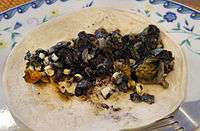 Huitlacoche corn taco
Huitlacoche corn taco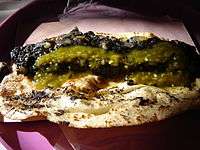 Quesadilla de huitlacoche, as it's often served in central Mexico
Quesadilla de huitlacoche, as it's often served in central Mexico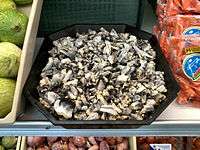 Huitlacoche for sale in the produce department of a Soriana store in Mexico
Huitlacoche for sale in the produce department of a Soriana store in Mexico
Recipes of Mexico
A simple Mexican-style succotash can be made from chorizo, onions, garlic, serrano peppers, huitlacoche, and shrimp with salsa taquera. The mild, earthy flavors of the huitlacoche blend nicely with the fats of the chorizo and bond to mellow out the heat from the peppers and salsa.
Another Mayan favorite on the Riviera Maya (Cancun to Tulum) is to add huitlacoche to omelettes. Once again, its earthy flavors bond with the fats that cook the eggs to mellow the flavors into a truffle-like taste.
Huitlacoche is also popular in quesadillas with with Mexican cheese , sauteed onions, and tomatoes.
The blueish color transforms into the recognizable black color only with heat. Any dish with huitlacoche must include a slow simmer of the fungus until it becomes black, which also removes most of the starch of the corn, and what is left is a black oily paste.
Availability
In Mexico, huitlacoche is mostly consumed fresh and can be purchased at restaurants or street or farmer's markets throughout the country and, to a much lesser extent, can also be purchased as a canned good in some markets and via the internet. Farmers in the countryside have been known to spread the spores around intentionally to create more of the fungus. In some parts of the country, they call the fungus "hongo de maiz", i.e. "maize fungus".[25]
Nutritional value
When corn smut grows on a corn cob, it changes the nutritional worth of the corn it affects. Corn smut contains much more protein than regular corn does. The amino acid lysine, of which corn contains very little, abounds in corn smut.[26]
See also
- Edible mushroom – Fleshy and edible fruit bodies of several species of macrofungi
- Medicinal fungi
References
- Ustilago maydis in Index Fungorum
- "Common smut of corn". apsnet.org. American Phytopathological Society. Retrieved 2018-10-06.
- "Ustilago maydis (DC.) Corda". Species. GBIF. Retrieved 2018-10-06.
- Vegetables, Revised: The Most Authoritative Guide to Buying, Preparing, and Cooking, with More than 300 Recipes (Google eBook) Page 184, by James Peterson, Random House LLC, Mar 27, 2012 Accessed October 24, 2013 via Google Books
- Guido Gómez de Silva, "Diccionario breve de mexicanismos", Fondo de Cultura Económica, Mexico 2001. Entries for "huitlacoche" and "cuicacoche o cuiltacoche".
- Producción de caviar azteca en invernadero, Teorema Ambiental, published August 2006. Retrieved April 2010 (Spanish)
- The Guardian City Guide. November 8, 2008.
- Wolff, Barbara. Professor introduces unusual edible fungus to Madison, University of Wisconsin - Madison News, September 19, 2006.
- Raúl Marcó del Pont, Guía de aves canoras y de ornato, Conabio-ine-semarnap, Instituto Nacional de Ecología, Mexico 1997. p. 66-70.
- Irene Vasconcelos Dueñas, Los hongos medicinales en México, Mexico, August 2007. (retrieved April 2010) (Spanish)
- Page 109 By Nicholas P. Money Professor of Botany Miami University, Ohio Publcihed by Oxford University Press, Aug 4, 2006. Accessed online vis Google Books October 24, 2013.
- Banuett, F. (1995). "Genetics of Ustilago Maydis, A Fungal Pathogen that Induces Tumors in Maize". Annual Review of Genetics. 29 (1): 179–208. doi:10.1146/annurev.ge.29.120195.001143. PMID 8825473.
- Christensen, J.J. (1963). "Corn smut caused by Ustilago maydis. Monograph no. 2". Amer. Phytopath. Society.
- Molina, L; Kahmann, R (2007). "An Ustilago maydis gene involved in H2O2 detoxification is required for virulence". Plant Cell. 19 (7): 2293–2309. doi:10.1105/tpc.107.052332. PMC 1955693. PMID 17616735.
- Kojic, M; Zhou, Q; Lisby, M; Holloman, WK (2006). "Rec2 interplay with both Brh2 and Rad51 balances recombinational repair in Ustilago maydis". Mol Cell Biol. 26 (2): 678–688. doi:10.1128/MCB.26.2.678-688.2006. PMC 1346908. PMID 16382157.
- Kämper J, Kahmann R, Bölker M, et al. (November 2006). "Insights from the genome of the biotrophic fungal plant pathogen Ustilago maydis". Nature. 444 (7115): 97–101. doi:10.1038/nature05248. PMID 17080091.
- Ferguson, DO; Holloman, HK (1996). "Recombinational repair of gaps in DNA is asymmetric in Ustilago maydis and can be explained by a migrating D-loop model". PNAS USA. 93 (11): 5419–5424. doi:10.1073/pnas.93.11.5419. PMC 39261. PMID 8643590.
- Kojic, M; Kostrub, CF; Buchman, AR; Holloman, WK (2002). "BRCA2 Homolog Required for Proficiency in DNA Repair, Recombination, and Genome Stability in Ustilago maydis". Molecular Cell. 10 (3): 683–691. doi:10.1016/S1097-2765(02)00632-9. PMID 12408834.
- Geiser, Elena; Wiebach, Vincent; Wierckx, Nick; Blank, Lars M. (2014-01-01). "Prospecting the biodiversity of the fungal family Ustilaginaceae for the production of value-added chemicals". Fungal Biology and Biotechnology. 1: 2. doi:10.1186/s40694-014-0002-y. ISSN 2054-3085. PMC 5598272. PMID 28955444.
- Uribe, Monica Ortiz (2009-08-20). "In Mexico, Tar-Like Fungus Is A Delicacy". Retrieved 2009-08-20.
- Newhall, Edith (25 September 1989). "Fungus Feast". New York Magazine: 44.
- TEMPTATION; Mexico's Answer To the Truffle By FLORENCE FABRICANT Published: August 30, 2000 New York Times. Accessed via NYTIMES online archives March 17, 2014
- Corn Smut, Mexican Truffles by GREEN DEANE, December 2012. Archive of food Blog: Eat the weeds and other things too... - Accessed online March 17, 2014
- O'Dowd, Michael J. (2001). The History of Medications for Women. Taylor & Francis. ISBN 978-1-85070-002-9. p. 410, via Google Books
- Laferrière, Joseph E. 1991. "Mountain Pima ethnomycology". Journal of Ethnobiology 11(1):15–-160.
- Battillo, J. (2018). "The role of corn fungus in Basketmaker II diet: A paleonutrition perspective on early corn farming adaptations". Journal of Archaeological Science: Reports. 21: 64–70. doi:10.1016/j.jasrep.2018.07.003.
- McGee, Harold (2004). On Food and Cooking (revised ed.). Scribner. p. 349 "Huitlacoche, or Corn Smut". ISBN 978-0-684-80001-1.
External links
| Wikimedia Commons has media related to Ustilago maydis. |